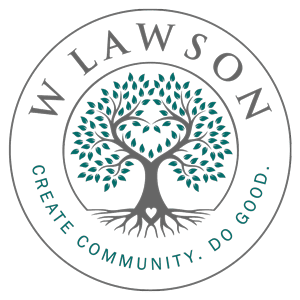
Developing an Inclusion Strategy for the Future of Aging Services
By Marvell Adams Jr.
As we look to the future, the demographic shifts within the aging population present both challenges and opportunities for organizations providing aging services. At W Lawson, we specialize in creating communities that embrace inclusion and belonging, with a focus on aging services and housing development. This white paper explores the importance of developing an inclusion strategy in the face of these demographic changes and outlines how organizations can begin to implement such strategies to better serve a diverse and evolving population.
The Changing Demographics of Aging
The aging population in the United States is rapidly expanding. According to projections, the number of adults aged 65 and older will increase by 47% between 2023 and 2040, from 56 million to 81 million individuals. This shift is largely driven by the Baby Boomer generation entering retirement age. However, these figures don’t tell the whole story. The racial and ethnic composition of the older adult population is becoming more diverse, with Black, Indigenous, and people of color (BIPOC) expected to grow by 107% in the same period. The LGBTQ+ community also represents a growing segment of the aging population, with estimates suggesting 6 million LGBTQ+ individuals over the age of 65.
These trends present an urgent need for aging services providers to rethink how they engage with diverse communities. Historical patterns of service provision have often been limited to affluent, predominantly white older adults, leaving many underserved communities with unmet needs. As the population of older adults becomes more racially and ethnically diverse, the imperative for inclusive housing and services becomes increasingly clear. Failure to adapt to these changes risks leaving organizations behind.
The Business Case for Inclusion
Creating an inclusion strategy is not only the right thing to do—it is also a smart business decision. The aging services industry, particularly in the housing and community development sectors, is facing a pressing need for new models of care and engagement. Traditional services have often failed to meet the needs of a more diverse aging population. The market for aging services providers is shifting, and organizations that fail to adopt inclusive strategies will struggle to maintain relevance in the coming decades.
The changing demographics present an opportunity to capture a growing market of older adults who come from varied racial, ethnic, and sexual orientations. The older white population will begin to decline around 2040, while the number of older adults who identify as two or more races will continue to rise. This shift in demographics means that the populations traditionally served by aging services providers are beginning to shrink, and new, more inclusive strategies are necessary to address the needs of a diverse client base.
Key Components of an Inclusion Strategy
At W Lawson, we focus on helping organizations develop comprehensive inclusion strategies that align with the future of aging services. A successful inclusion strategy requires a multi-faceted approach, combining engagement, assessment, shared learning, and plan development. These elements should be seamlessly integrated into the organization’s core values and mission to ensure sustainable change. Below, we outline the key components of a successful inclusion strategy:
- Engagement
The first step in any inclusion journey is engagement. Engagement is not simply about training or assessments; it is about building relationships and creating open lines of communication within the organization. This means engaging with staff, residents, and stakeholders to ensure that all voices are heard. For organizations serving older adults, this includes reaching out to employees who may have been working with residents for years and ensuring their perspectives are valued. Engaging with staff and residents on an ongoing basis helps organizations understand the unique needs of the populations they serve and creates a foundation for implementing inclusive practices.
- Assessment
Once engagement has begun, organizations must assess their current practices and understand the gaps in service provision. This means evaluating the organization’s historical practices and identifying areas where inclusion efforts may have been lacking. For example, organizations should reflect on the historical legacy of their buildings and land, considering how wealth has been accumulated and where potential exclusions may have occurred. An assessment allows organizations to identify specific areas where they can improve and where they need to adjust their strategies to better serve diverse populations.
- Shared Learning
Inclusion is not a one-time training or checklist—it is an ongoing process of learning and growth. Organizations must create a space for shared learning, where staff, leadership, and residents can learn from each other and engage in meaningful conversations about diversity, equity, and inclusion. Shared learning involves leveling the playing field and ensuring that all members of the organization are on the same page in terms of their understanding of inclusion and what it means for their work. This shared learning process can include training, discussions, and the sharing of resources and best practices.
- Plan Development
Once engagement, assessment, and shared learning are underway, organizations can begin developing a concrete inclusion plan. This plan should include measurable goals, strategies, and a framework for ensuring accountability at all levels of the organization. The inclusion plan should not be siloed but integrated into the overall organizational strategy, with clear objectives for recruiting diverse staff, developing inclusive housing models, and serving diverse resident populations. The plan should include specific actions to address gaps in service provision and identify ways to ensure that leadership, governance, and staff are aligned in their commitment to inclusion.
360-Degree Accountability
To ensure that an inclusion strategy is successful, it must be supported by 360-degree accountability. This means that staff, leadership, and the board of directors must all be accountable for implementing the inclusion strategy. Each group should have a clear understanding of their role in promoting inclusion, and there must be mechanisms in place for measuring progress and making adjustments as needed. Accountability ensures that inclusion is not just a buzzword but a fundamental part of the organization’s culture and operations.
Moving Forward: The Importance of Inclusion in Aging Services
In conclusion, as the demographic landscape of aging services continues to evolve, organizations must adapt by embracing inclusive practices. The aging population is becoming more diverse, and those organizations that fail to recognize this shift will struggle to remain competitive. The business case for inclusion is clear: organizations that embrace diversity and inclusion are better positioned to serve a growing and diverse client base while fostering a more engaged and satisfied workforce.
At W Lawson, we are committed to helping organizations navigate th future of aging and develop inclusion strategies that will allow them to thrive in the future. By focusing on engagement, assessment, shared learning, and plan development, organizations can build inclusive communities that serve all individuals, regardless of their background, identity, or experience.
References
- U.S. Census Bureau. (2020). Projections of the size and composition of the U.S. population: 2014 to 2060. Retrieved from https://www.census.gov
- LeadingAge. (2021). The State of Aging Services: Demographic Shifts and Market Trends. Retrieved from https://www.leadingage.org
- SAGE USA. (2020). Creating an inclusive aging community: How diversity, equity, and inclusion are shaping the future of aging services. Retrieved from https://www.sageusa.org


